
In 316 BC, Kassandros, son of Antipatros, general to Alexander the Great. married Thessaloniki, the half sister of Alexander and named the city after her.
We’ve been walking up and down the Leoforos Nikis that runs along the Gulf of Salonika. We can see the White Tower, the symbol of Thessaloniki from our hotel window.
We crossed (many times) the hundreds of jewelry and shoe stores along Tsimiski Street. We’ve been up and down the Agia Sofias Street that passes along the Byzantine churches of the Achiropitos and Agia Sofia and past the ancient Roman Forum (Agora).

We’ve been in and out of Aristotilous Square, the only part of Edward Hébrard’s design for the new city after the great fire of 1917.
We walked through the markets along Ermou Street. We’ve dined over in the Ladadika, the remains of the once great Jewish community near the Gulf.
We’ve been along the Agiou Domitriou Street to see the main Cathedral of Agios Dimitrious and a little further down the street, the (supposed) birth home of Mustapha Kemal, “Ataturk”, now the Turkish Embassy. We walked down the Via Egnatia that once ran from Rome to Constantinople. It was on the Via Egnatia where the Emperor Galerius built his great Palace although all that’s visibly left is part of his great arch and the beautiful brick Rotunda.
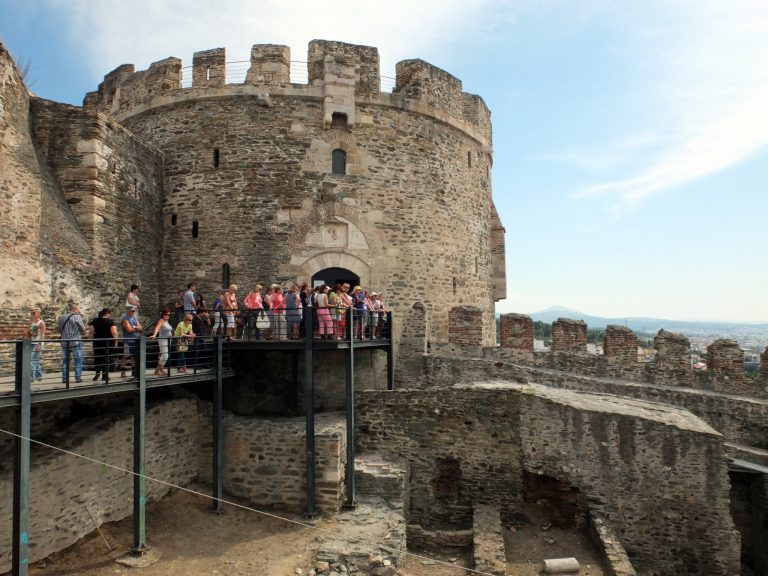 We walked up to the “Eptapirgio”, the great fortress (known as Yedi Kule by the Turks) overlooking the city in the upper town known as Ano Polis.
We walked up to the “Eptapirgio”, the great fortress (known as Yedi Kule by the Turks) overlooking the city in the upper town known as Ano Polis.
We sat in a beautiful café overlooking the Yeni Hammam. The lower12’ of the baths is buried under ground.
We walked over to the Paradise Hammam but it’s under wraps, being braced for the new Metro system. We asked an engineer when the Metro would be completed and the Hammam reopened. He shrugged his shoulders and said “this is Greece”.
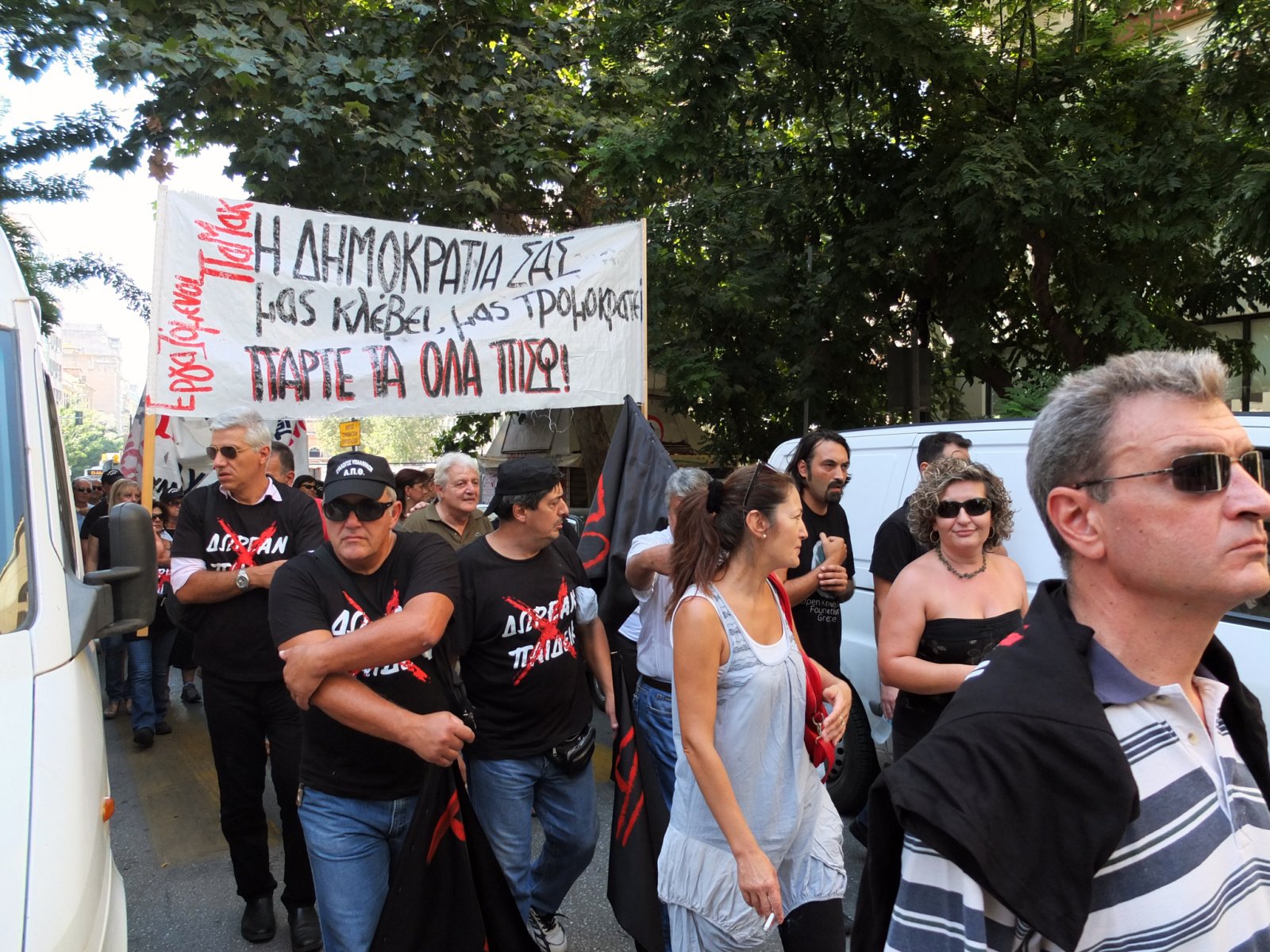 We saw the thousands arrive for the annual International Fair, one of the most important trade fairs in Greece and the Balkans. It’s been happening here since 1926. Last week, as customary, the Prime Minister made a public speech. This week, as customary, the opposition gets the stage. In support of the opposition there are protest marches throughout the city.
We saw the thousands arrive for the annual International Fair, one of the most important trade fairs in Greece and the Balkans. It’s been happening here since 1926. Last week, as customary, the Prime Minister made a public speech. This week, as customary, the opposition gets the stage. In support of the opposition there are protest marches throughout the city.
All in all, I think we can say that in 5 days we’ve seen a lot of Thessaloniki.
After the 42 AD Battle of Philippi when Augustus Caesar (then Octavian) and Mark Antony destroyed the armies of Marcus Junius Brutus and Gaius Cassius, two of the assassins of Julius Caesar, they made Thessaloniki into a free city. All residents became citizens of Rome. This was a big thing for the city and in turn, they deified Julius Caesar and started a cult of worship with Augustus as the head of the cult.
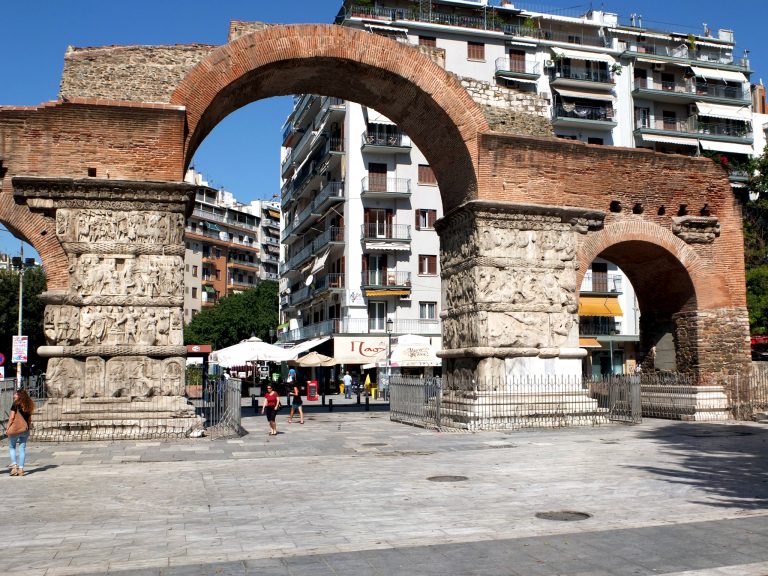
The Emperor Galerius (co Emperor with Constantine) built the Arch of Galerius and the Rotunda as part of his imperial palace here in the 4th century. The Arch, covered with the well preserved story of Galerius defeating the Sasasian Empire (Persians) and the death of their King Narseh. The Arch was originally 8 pillars that formed a triple arch that was set on the crossroads of the two main Roman streets, the Cardo and the Decumanus (the Via Egnatia). Only two of the pillars remain. The locals refer to the Gate as the “Kamala” and it’s one of the most popular meeting places for people to grab a seat at a café and pass the time with friends playing cards or backgammon. Thessaloniki is a café culture city. The people sit at cafes from early morning till early morning. The tables are filled at 8am and at 3am. The idea of a poor Greece mired in austerity doesn’t make sense in this city.
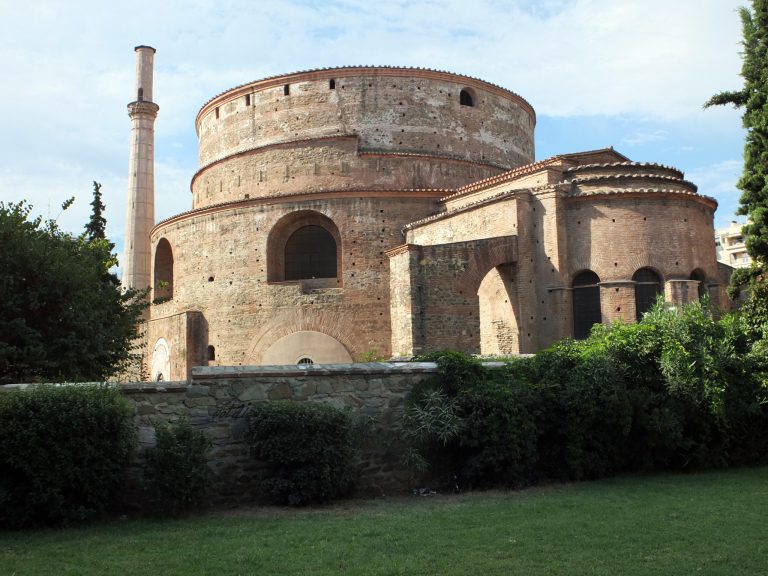 The Rotunda is a 80’ diameter brick round building originally built with an oculus similar to the Pantheon in Rome. The walls are more than 20’ thick and the top is close to 100’ high. It very impressive. Some think it was intended to be used as a mausoleum for Galerius but he was buried at his palace in Felix Romuliana in Serbia.
The Rotunda is a 80’ diameter brick round building originally built with an oculus similar to the Pantheon in Rome. The walls are more than 20’ thick and the top is close to 100’ high. It very impressive. Some think it was intended to be used as a mausoleum for Galerius but he was buried at his palace in Felix Romuliana in Serbia.
The Rotunda (also known as the Agios Georgios or the Rotunda of St George) is the oldest building in the city. It’s been used for everything from religious worship to performances of whirling dervishes and contemporary jazz concert.
The Rotonda was converted to a mosque in 1590. When the Greeks took back the city in 1912, they turned it back into a church but left the minaret. The Orthodox want to tear down the minaret and restore the Rotunda to the Agios Georgios but the Heritage committee wants to keep it as a cultural center. Right now it’s being restored. I hope the status as a Heritage Museum will prevail. It’s an amazing place for a concert. The acoustics are delightful and I think the city already has enough churches.
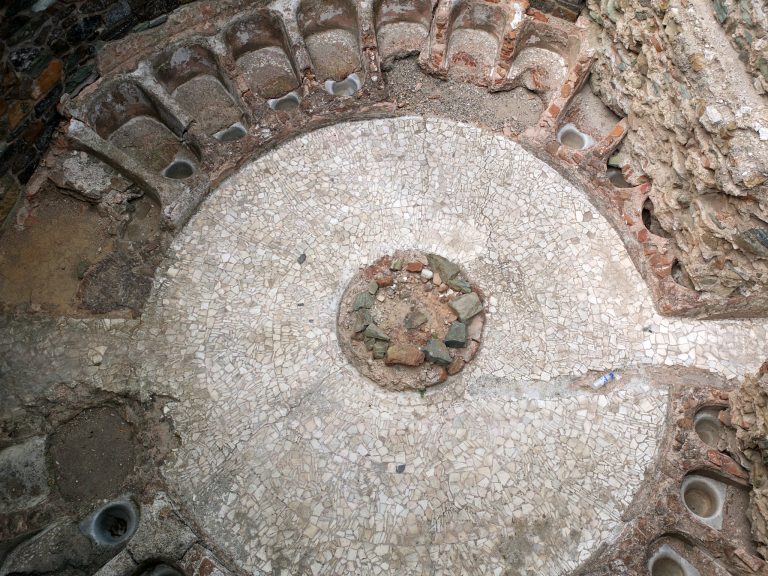
The isn’t much left of the ancient Roman Forum (the Agora), but the individual bath tubs are magnificent. We’ve never seen anything like it. There is the restored Bouleterion, the Odeon Theatre that once held a audience of up to 4,000. These days it’s used for concerts.
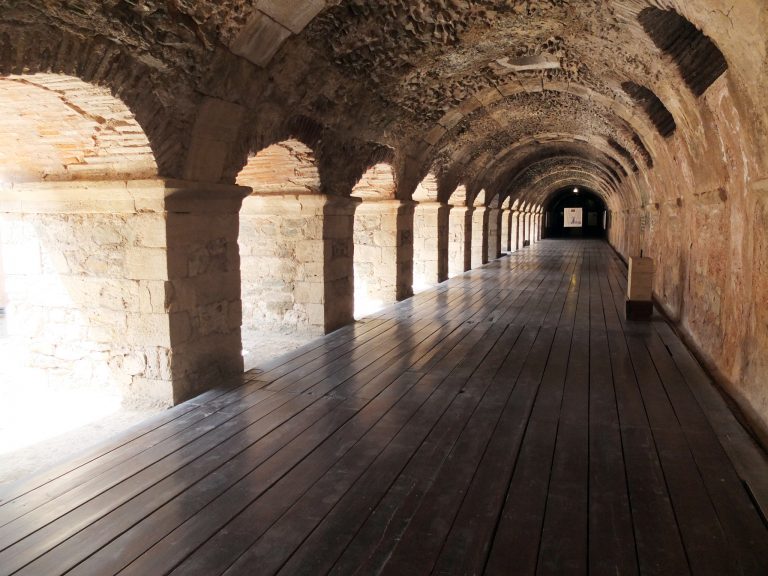
Most of the Forum fell out of style in the 5th century but the shops on the lower level stayed in use until the 15th century. There is a nice museum of the history of the Agora in the place that once held the Agora Shops.
By the time of Theodosius the Great in the 4th century, Thessaloniki was a large prosperous city with a great harbor, a grand palace, a protective fortress wall and a large hippodrome. Sports fans in the Eastern Roman Empire were even crazier than the Football Hooligans of today.
In 390, Butheric, the Magistrate of Thessaloniki arrested one of the favorite charioteers for offense of homosexuality. The people demanded his release but Butheric refused and so an armed revolt followed and they killed Butheric and a few Roman officers. Theodosius was so pissed when he heard the news he sent in the Gothic troops. The result was the massacre of 7,000 people.
Although this was pretty a brutal punishment, in 532 AD Constantinople, after a few charioteers from the favorite Blue and Green clubs were arrested for murders in a brawl after a race, the whole thing turned into what is now known as the Nika Riots that ended up destroying over half the city and killing over thousands of people. The football hooligans of the 21st century have nothing on the ancient Romans.
There are bits and pieces of the 4th – 6th centuries but most of it is still buried or carted away. The statues of the Daughters of the King of Thrace, named the “Incantadas” by the Sephardic Jews who lived under them in the 15th century are now in the Louvre. As the legend goes, the daughters were turned into petrified stone as punishment for their ‘erotic passion with Alexander the Great’.
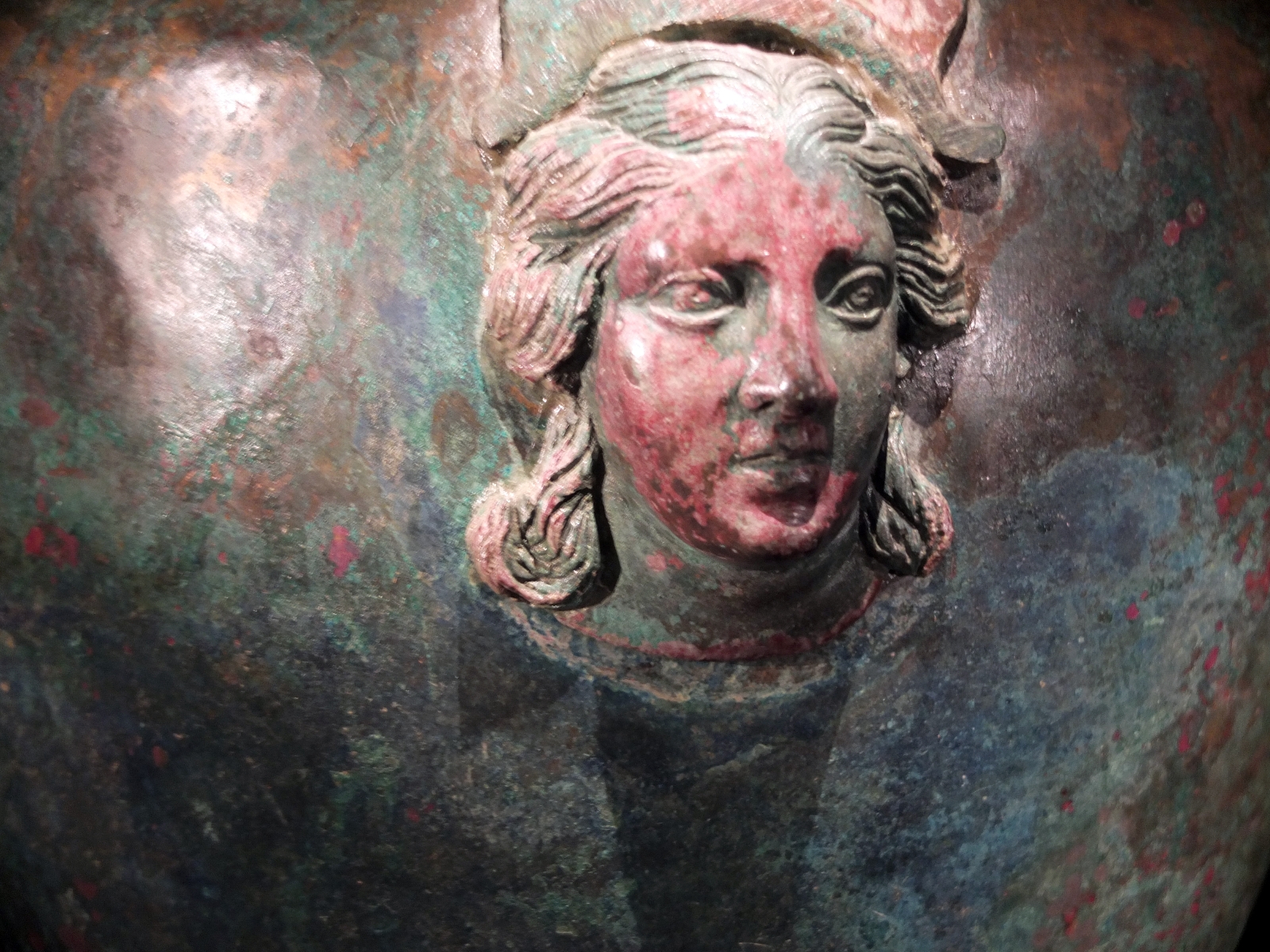 However, if you really want to see some of the amazing beauty and wealth of ancient Thessaloniki, head on over to the Archeology Museum. It’s near the White Tower and across the street from the Convention Center. Some of it looks as if it was recently made. The ancient glass (4th-6th century BC) was made of pulverized flint, calcium and soda from natron, all heated to 1100° C. (2012° F). The gold bracelets, the brass pots, the carvings, they are some the best examples of ancient Greek and Roman art we’ve ever seen. When an archeology museum is done correctly, this is what it looks like. You can buy a joint ticket that also gets you into the Byzantine Museum next door. We came to Thessaloniki to study the Byzantine art and we were really excited to see the Byzantine Museum. It’s an OK museum but not nearly as good as the Archeology.
However, if you really want to see some of the amazing beauty and wealth of ancient Thessaloniki, head on over to the Archeology Museum. It’s near the White Tower and across the street from the Convention Center. Some of it looks as if it was recently made. The ancient glass (4th-6th century BC) was made of pulverized flint, calcium and soda from natron, all heated to 1100° C. (2012° F). The gold bracelets, the brass pots, the carvings, they are some the best examples of ancient Greek and Roman art we’ve ever seen. When an archeology museum is done correctly, this is what it looks like. You can buy a joint ticket that also gets you into the Byzantine Museum next door. We came to Thessaloniki to study the Byzantine art and we were really excited to see the Byzantine Museum. It’s an OK museum but not nearly as good as the Archeology.
Saint Demetrios (martyred in the 4th century) is the patron Saint of the city. He saved the city from obliteration a number of times until Sultan Murad II conquered it in 1430. Many feel that Demetrios was so pissed off at the local Christians for giving the city to Murad II that he just left them.
However, the Saint finally had a change of heart and on the day after his feast day on October 27, 1912, he gave the city back to them as the Greek Army finally defeated the Ottomans.
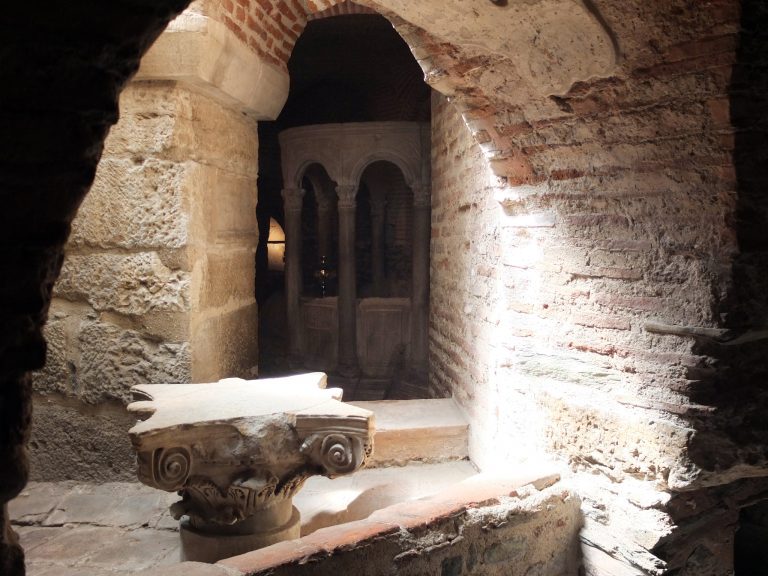
The Agios Demetrios is built over the old Roman prison where Demetrios was martyred. He was killed by several spears and consequently he is always shown with spear wounds.
The Cathedral dates back to the 4th century although it’s gone through many renovations. It was mostly destroyed in the great fire of 1917. The latest renovation was done in 1949.
The White Tower is City’s most coveted monument. It was probably built by the Venetians when they were given the city in1423 but most believe it was constructed by the Ottomans after 1430 when Murad II defeated the Venetians here and claimed the city. Many believe it was built by the most famous Ottoman architect Mimar Sinan as part of the fortifications of the city but Sinan wasn’t even born until 1490.
The tower became a prison in the 19th century. In 1826, the Janissary guards of Murad II revolted against the Sultan for the last time. The Janissary got so powerful they decided they should get more money for doing less. This time it didn’t work and instead of a pay raise, most of them were imprisoned in the tower and executed. It was the end of the Janissary guards. The Bektashi sect of the Sufi order (the core of the Janissary cult) was also ordered to disband.
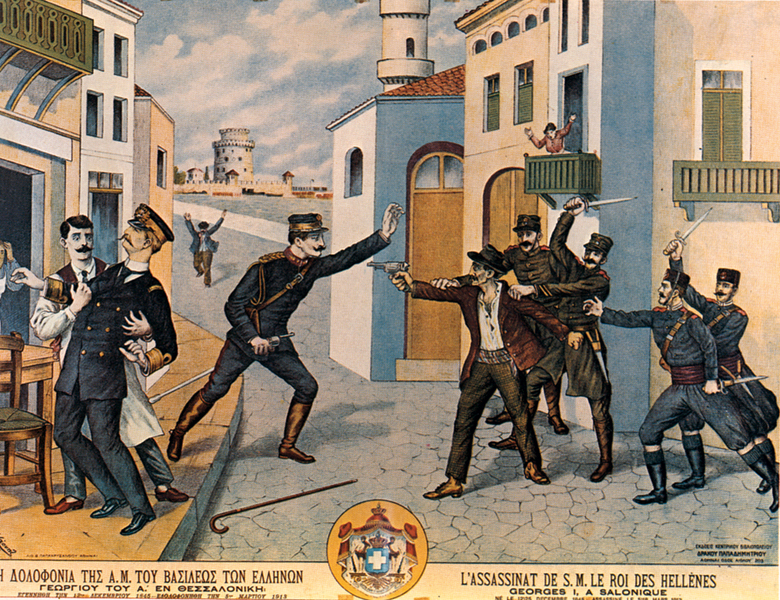
On March 18, 1913, King George I of Greece was out for a stroll and as he walked by the White Tower, he was assassinated, shot in the back by Alexandros Schinas, a vagrant drunk and (supposed) anarchist, who said he killed the King because he refused to give him money. Schinas died 6 weeks later from defenestration (he was tossed out of a police station window). The tower is now a museum of the history of Thessaloniki.
Jewish Thessaloniki
During the early Ottoman rule, the city became a melting pot of Muslim, Christian and Jewish communities. Thessaloniki was one of the largest Jewish communities in Europe. Jews had been there since the 1st century and claim to have had Paul of Tarses (who became St Paul) preach in their synagogue but when the Jews fled the Spanish Inquisition in 1492, many of them were welcomed in Thessaloniki. The community grew with the arrival of refuge Jews from Italy, Portugal and France. By the early 17th century close to 70% of the population of Thessaloniki was Jewish.
By the 20th century political actions in Greece and Turkey caused a major exodus of the Salonica Jews and by the 1930s there were about 55,000 remaining. They were all were all shipped off to the camps during the Nazi occupation, most of them were killed.
Some Greeks did their best to save the lives of the local Jews. Between the Archbishop of Greece Damaskenos and Angelos Evert, the chief of Police, they issued 27,000 fake IDs along with police uniforms for Jews to escape.
Upon their deportation, the Christian citizens ransacked their houses looking for valuable treasures. Floors were torn up, furniture pulled apart, walls broken down, even graves were dug up thinking the Jews might have buried treasures with the dead.
A little over 1,000 of the Jewish population survived. When the survivors did come back after the war, their houses were all occupied by Christian families who had purchased them from the Nazi Germans and who were very reluctant to give them back to their rightful owners. The Greek government did eventually pay the State of Israel the value of much of the confiscated Jewish property. Today there are about 1500 Jews living in the city.
In the 16th century, Salonica became a center of study for Kabbalists, Jewish mysticism and the home of two of the most famous “new Messiahs”. After predicting the sack of Rome in 1527 , Solomon Molcho declared himself to be the new messiah, but after sitting at the gates of Rome for 30 days, praying for its destruction, he was burned at the stake.
In the mid 1600’s, Sabbatai Zevi proclaimed himself to be the new messiah but after a stint in a Turkish prison he agreed to convert to Islam. Supposedly he recanted his conversion to his followers who still exist today. They’re known as the Sabbateans.
Constantine (Cyril) and Methodius, two brothers from 9th century Thessaloniki translated the Slavic language into a written text known as Glagolitic alphabet to introduce the great Slavic tribes to Christianity. After their death their students carried on the work, translating and teaching the alphabet to tribes throughout the Byzantine Empire. Today the brothers are known as the ‘Apostles of the Slavs’ and their script, the Cyrillic language is still used from Greece on east to Mongolia.
The Great Fire
On August 18, 1917, a fire broke out in the old Turkish quarter of the city. Eventually it wiped out a third of the city. The fire burned for over 30 hrs. and in the end, over 70,000 people were homeless. The Government hired the French Architect Ernest Hébrard to redesign the city. His designs were beautiful and costly and the only part that actually got built was Aristotilous Square. It was World War I and funds weren’t too readily available.
Mustafa Kemal or Ataturk, the father of Modern Turkey was born in Thessaloniki and his birth home is now the Turkish embassy. However, the whole story is suspicious. The date of his birth in 1881 is unknown. His mother said it was during the winter between Dec 22 and Jan 1. Mustafa Kemal said he heard it was during the Spring. He birth date is celebrated on May 19.
The other point of contention is whether this is even the house where he was born. A historian in Istanbul told us that in 1984, the Turkish Government asked the Greek government for the right to build the Turkish embassy at the birth home of Ataturk. The Greeks said “why not” and gave the Turks this house. However, according to the Turkish historian, it was the house where Ataturk stayed on his diplomatic visits to Greece but was not the house where he was born.
The Turks, nonetheless, ran with it and recreated the entire story of his birth, with rooms commemorating the years of his youth, a spooky wax likeness of him and even down to the room the little baby Mustafa was born into.
Greek wines have come a long way from Retsina. These days there are some of best Greek wines come from the north up here near Thessaloniki in the area known as the Drama near Mount Pangaion, once the home of the cult of Dionysus. Now the wines from this region have the European classification as the Geographical Indication of Regional Wine of Drama.
We had a few really good reds. Thema from Kitma Pavlidis winery 2009 is an excellent dark purple blend of Syrah and Agiorgitiko grapes with a deep spicy aroma and very smooth taste. The dark purple Techni-Alipias Red from Wine Art Estates is made from Cabernet Sauvignon, Agiorgitiko and Merlot grapes. They are both available in other parts of Europe and the US and we highly recommend both of them.
The other unique treat of Thessaloniki is Bougaza, a flakey pastry filled with either cream, meat, cheese and occasionally covered with powdered sugar or cinnamon. They are cooked in large rectangular shapes and then cut into small pieces when you order them. It’s usually just a breakfast treat.
The food is typical Greek tavern style or bar food, there are hundreds of bars serving everything all day and all night. Most of the good ones are in the Ladadika zone near Aristotilous Square. We ate a great meal at Grada Nuovo, near the Freedom Square and close to the Aristotle Square. This is mostly a fish restaurant with an Italian influence. The food is very fresh, delicious, beautifully presented and at a very reasonable price.
For more photos of Thessaloniki, click here.
You must be logged in to post a comment.